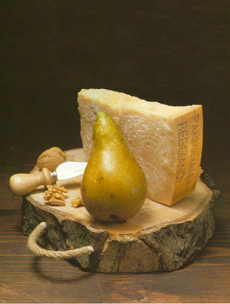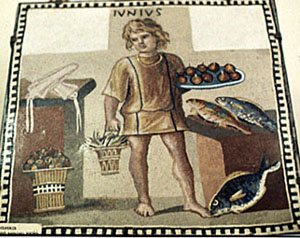
 Parmigiano-Romano may have begun in ancient Rome as a cheese called La Luna. Photo courtesy Fanticini.com.
September 2005
Last Updated June 2018
|
 |
The History Of Cheese
Page 2: The Romans Master Cheese-Making
This is Page 2 of a six-page article on the history of cheese. Click on the black links below to visit other pages.
The Romans Master Cheese-Making
It was the Roman culture that developed the art of cheesemaking as we know it today. Roman cheesemakers were skilled artisans, and the Roman culture developed many varieties of cheese that resemble those we enjoy today. The Romans are credited with the first aging of cheese, or cheese storage. They were aware of the affects of various ripening techniques upon the taste and character of a particular cheese.
|

Photo courtesy of VRoma.org. |
It is likely that the Romans brought cheese and the art of cheesemaking with them as they conquered Gaul—what we now know as France and England—where it was embraced enthusiastically. The ancestors of today’s French cheesemakers did their job by perfecting the art of cheese aging, which today is known by the French term, l’affinage.
The larger Roman houses had a separate cheese kitchen, the caseale, and special areas where cheeses could be matured. In larger towns, homemade cheeses could be taken to a special center to be smoked. Some written notes on cheesemaking survive:
- Homer, circa 1184 B.C.E., refers to cheese being made in the mountain caves of Greece from the milk of sheep and goats, specifying a variety called Cynthos sold by the Greeks to the Romans (perhaps the Feta cheese of today).
- Aristotle, who lived from 384 to 322 B.C.E., commented on cheese made from the milk of mares and asses. Russian koumiss is made from mare’s milk and is fermented to provide an alcoholic content of up to 3%.
- Varro, circa 127 B.C.E., noted the difference in cheeses made from a number of locations and commented on their digestibility. By this time the use of rennet was commonplace, providing the cheesemaker with far greater control over the types of curd produced. Cheese had started to move from subsistence food, produced for home consumption, to a commercial product.
- Columella, circa 50 C.E., wrote about how to make cheese in considerable detail. Cheesemakers today would be perfectly at home with many of the principles he set out so clearly more than 1900 years ago.
The First Cheese Exporter?
By 300 C.E., cheese was being regularly exported by Rome to countries along the Mediterranean seaboard. Trade had developed to such an extent that the emperor Diocletian had to fix maximum prices for a range of cheeses, including an apple-smoked cheese highly popular with Romans. Another cheese was stamped and sold under the brand name of La Luna, possibly the precursor of today’s Parmigiano-Romano, the name of which first appeared in 1579.
Like other areas of knowledge, Roman cheesemaking expertise spread with their empire throughout Europe. Roman soldiers who had completed their military service and intermarried with the local populace, set up coloniae farms in retirement, where they may well have passed on their skills in cheesemaking.
With the collapse of the Roman Empire around 410, cheesemaking spread slowly via the Mediterranean, Aegean and Adriatic seas to Southern and Central Europe. The river valleys provided easy access and methods adopted for production were adapted to suit the different terrain and climatic conditions. Goats and sheep provided plenty of milk.
Continue To Page 3: Stylistic Differences Evolve
Go To The Article Index Above

|




 Parmigiano-Romano may have begun in ancient Rome as a cheese called La Luna. Photo courtesy Fanticini.com.
Parmigiano-Romano may have begun in ancient Rome as a cheese called La Luna. Photo courtesy Fanticini.com. 